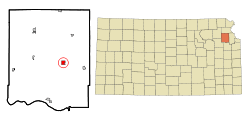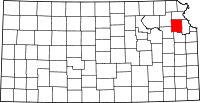Oskaloosa, Kansas
| Oskaloosa, Kansas | |
|---|---|
| City | |
|
Business district of Oskaloosa (2014) | |
 Location within Jefferson County and Kansas | |
 KDOT map of Jefferson County (legend) | |
| Coordinates: 39°12′57″N 95°18′50″W / 39.21583°N 95.31389°WCoordinates: 39°12′57″N 95°18′50″W / 39.21583°N 95.31389°W | |
| Country | United States |
| State | Kansas |
| County | Jefferson |
| Area[1] | |
| • Total | 1.03 sq mi (2.67 km2) |
| • Land | 1.02 sq mi (2.64 km2) |
| • Water | 0.01 sq mi (0.03 km2) |
| Elevation | 1,119 ft (341 m) |
| Population (2010)[2] | |
| • Total | 1,113 |
| • Estimate (2012[3]) | 1,096 |
| • Density | 1,100/sq mi (420/km2) |
| Time zone | Central (CST) (UTC-6) |
| • Summer (DST) | CDT (UTC-5) |
| ZIP code | 66066 |
| Area code(s) | 785 |
| FIPS code | 20-53375 [4] |
| GNIS feature ID | 0478510 [5] |
| Website | City Website |
Oskaloosa is a city in and the county seat of Jefferson County, Kansas, United States.[6] As of the 2010 census, the city population was 1,113.[7] Oskaloosa is part of the Topeka, Kansas Metropolitan Statistical Area.
History
Oskaloosa was founded in 1856.[8] It was named after the city of Oskaloosa, Iowa.[9]
The first post office in Oskaloosa was established in November 1856.[10]
Geography
Oskaloosa is located at 39°12′57″N 95°18′50″W / 39.21583°N 95.31389°W (39.215849, -95.313800).[11] It is at the intersection of U.S. Route 59 and K-92, approximately 15 miles north of Lawrence. According to the United States Census Bureau, the city has a total area of 1.03 square miles (2.67 km2), of which, 1.02 square miles (2.64 km2) is land and 0.01 square miles (0.03 km2) is water.[1]
Climate
The climate in this area is characterized by hot, humid summers and generally mild to cool winters. According to the Köppen Climate Classification system, Oskaloosa has a humid subtropical climate, abbreviated "Cfa" on climate maps.[12]
Demographics
| Historical population | |||
|---|---|---|---|
| Census | Pop. | %± | |
| 1860 | 631 | — | |
| 1870 | 640 | 1.4% | |
| 1880 | 725 | 13.3% | |
| 1890 | 773 | 6.6% | |
| 1900 | 978 | 26.5% | |
| 1910 | 851 | −13.0% | |
| 1920 | 700 | −17.7% | |
| 1930 | 733 | 4.7% | |
| 1940 | 800 | 9.1% | |
| 1950 | 721 | −9.9% | |
| 1960 | 807 | 11.9% | |
| 1970 | 955 | 18.3% | |
| 1980 | 1,092 | 14.3% | |
| 1990 | 1,074 | −1.6% | |
| 2000 | 1,165 | 8.5% | |
| 2010 | 1,113 | −4.5% | |
| Est. 2015 | 1,086 | [13] | −2.4% |
| U.S. Decennial Census | |||
2010 census
As of the census[2] of 2010, there were 1,113 people, 435 households, and 281 families residing in the city. The population density was 1,091.2 inhabitants per square mile (421.3/km2). There were 480 housing units at an average density of 470.6 per square mile (181.7/km2). The racial makeup of the city was 97.0% White, 0.2% African American, 0.8% Native American, 0.3% Asian, 0.1% from other races, and 1.6% from two or more races. Hispanic or Latino of any race were 0.9% of the population.
There were 435 households of which 33.1% had children under the age of 18 living with them, 43.2% were married couples living together, 16.8% had a female householder with no husband present, 4.6% had a male householder with no wife present, and 35.4% were non-families. 29.2% of all households were made up of individuals and 14.5% had someone living alone who was 65 years of age or older. The average household size was 2.43 and the average family size was 3.03.
The median age in the city was 39.3 years. 24.5% of residents were under the age of 18; 9% were between the ages of 18 and 24; 23.1% were from 25 to 44; 24.8% were from 45 to 64; and 18.4% were 65 years of age or older. The gender makeup of the city was 50.3% male and 49.7% female.
2000 census
As of the census[4] of 2000, there were 1,165 people, 439 households, and 291 families residing in the city. The population density was 1,281.5 people per square mile (494.3/km²). There were 478 housing units at an average density of 525.8 per square mile (202.8/km²). The racial makeup of the city was 98.03% White, 0.52% Native American, 0.69% from other races, and 0.77% from two or more races. Hispanic or Latino of any race were 1.97% of the population.
There were 439 households out of which 35.8% had children under the age of 18 living with them, 49.7% were married couples living together, 11.6% had a female householder with no husband present, and 33.5% were non-families. 29.8% of all households were made up of individuals and 15.5% had someone living alone who was 65 years of age or older. The average household size was 2.53 and the average family size was 3.14.
In the city the population was spread out with 28.3% under the age of 18, 8.7% from 18 to 24, 26.0% from 25 to 44, 18.4% from 45 to 64, and 18.6% who were 65 years of age or older. The median age was 37 years. For every 100 females there were 94.2 males. For every 100 females age 18 and over, there were 87.6 males.
The median income for a household in the city was $33,684, and the median income for a family was $41,477. Males had a median income of $35,043 versus $23,295 for females. The per capita income for the city was $15,677. About 9.8% of families and 13.5% of the population were below the poverty line, including 14.4% of those under age 18 and 9.4% of those age 65 or over.
Notable people
- McKinley Burnett, leading figure in Brown v. Board of Education.
- James Reynolds, actor on Days of Our Lives for over 30 years.
- C. Wesley Roberts, Chairman of the Republican Party, father of U.S. Senator Pat Roberts.
- Dummy Taylor, deaf Major League Baseball pitcher.
- Roger Barker, pioneering sociologist who studied everyday life in Oskaloosa.
References
- 1 2 "US Gazetteer files 2010". United States Census Bureau. Retrieved 2012-07-06.
- 1 2 "American FactFinder". United States Census Bureau. Retrieved 2012-07-06.
- ↑ "Population Estimates". United States Census Bureau. Retrieved 2013-05-29.
- 1 2 "American FactFinder". United States Census Bureau. Retrieved 2008-01-31.
- ↑ "US Board on Geographic Names". United States Geological Survey. 2007-10-25. Retrieved 2008-01-31.
- ↑ "Find a County". National Association of Counties. Retrieved 2011-06-07.
- ↑ "2010 City Population and Housing Occupancy Status". U.S. Census Bureau. Retrieved March 27, 2011.
- ↑ Kansas State Historical Society (1916). Biennial Report of the Board of Directors of the Kansas State Historical Society. Kansas State Printing Plant. p. 209.
- ↑ Carpenter, Tim (November 28, 1997). "What's in a name? Key elements of area history". Lawrence Journal-World. pp. 3B. Retrieved 28 April 2015.
- ↑ "Kansas Post Offices, 1828-1961 (archived)". Kansas Historical Society. Archived from the original on October 9, 2013. Retrieved 11 June 2014.
- ↑ "US Gazetteer files: 2010, 2000, and 1990". United States Census Bureau. 2011-02-12. Retrieved 2011-04-23.
- ↑ Climate Summary for Oskaloosa, Kansas
- ↑ "Annual Estimates of the Resident Population for Incorporated Places: April 1, 2010 to July 1, 2015". Retrieved July 2, 2016.
Further reading
- History of the State of Kansas; William G. Cutler; A.T. Andreas Publisher; 1883. (Online HTML eBook)
- Kansas: A Cyclopedia of State History, Embracing Events, Institutions, Industries, Counties, Cities, Towns, Prominent Persons, Etc; 3 Volumes; Frank W. Blackmar; Standard Publishing Co; 944 / 955 / 824 pages; 1912. (Volume 1 - Download 54MB PDF eBook), (Volume 2 - Download 53MB PDF eBook), (Volume 3 - Download 33MB PDF eBook)
External links
| Wikimedia Commons has media related to Oskaloosa, Kansas. |
- City
- Schools
- USD 341, local school district
- Maps
- Oskaloosa City Map, KDOT
